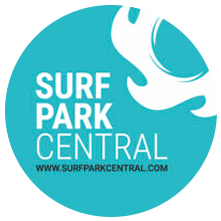By: Katie Rodriguez
Laurent Hequily has a grand vision when it comes to wave technology.
Born from a desire to combat some of the largest obstacles that exist for modern-day wave pools, Laurent’s artificial wave brainchild, the Okahina Wave, is the first of its kind to specifically target both the environmental and economic costs that come with creating a surf park.
An environmentally positive wave pool – as in, one that improves the environment in some capacity – sounds a bit like an oxymoron. It’s well known that to create a wave pool, developers usually need to have massive quantities of land, water, energy, and in most cases, concrete.
Already patented in 44 countries (including the U.S.) and developed by a French based company called Waveriding Solution, Laurent’s project sets out to be the world’s first environmentally positive, cost-effective and energy efficient wave generating technology on the market thus far. In fact, because Laurent’s artificial wave does not exist in a concrete environment, he prefers you don’t refer to his project as a wave pool at all.
The Okahina Wave concept is truly innovative. While there have been no commercial-scale prototypes to date, the proof of concept has already garnered interest from investors, the European Union, nonprofits, and developers. “Today, in France and Europe in general, all the project holders and investors are very careful of the type of project they’re investing in, especially on the environmental side of it,” says Laurent. “They decided to invest in the Okahina Wave because of our environmental design and a real care about our carbon, environmental and biodiversity footprint. That’s some of the main criteria for investments right now.”
Planned Okahina Wave Sites

Currently, there are four Okahina Wave sites in various stages of planning. The first, which will be the first commercial-scale prototype, is currently under development and will open to the public in Spring 2022 near the Futuroscope Theme Park between Paris and Bordeaux. The second will open at the Olympic site in Vaires-sur-Marne near Disneyland Paris in 2023, a year before the Paris Olympic Games. The third will open in the next few years in Libourne Saint-Emilion, and the fourth is undergoing planning for the latest hot spot in surfing, the French Alps.
Specifics of the Wave, Tech and Materials
The circular wave generating technology is what Laurent and his team refer to as a “floating atoll”, which consists of a platform anchored to the bottom of a body of water, surrounded by a rotating generator that creates the wave (no foils used here). By design, the technology has been crafted to omit the use of concrete, and because the wave is customized to be installed within bodies of water like bays, harbors and lakes, the Okahina Wave does not require any additional water.
The wave tech will come in three sizes (measured by diameter): 40m, 60m, and 110m. For the smaller facility, waves will range from 0.8m – 1.2m and require 50kWh (the energy cost needed to power a small electric car). The medium sized facility will produce waves ranging from 0.8m – 1.4m, requiring 120 kWh, and the large facility will produce waves ranging from 0.8m – 2m, requiring 350 kWh (the amount of energy needed to fully power a Tesla SUV). Waves will be generated every 12 seconds, and last up to 48 seconds – which, if proven, will be the longest artificial wave in the world to date (KSWC is currently the longest, with waves clocking in at 45 seconds).

Laurent and his team pay close attention to the Life Cycle Analysis, or “Cradle to Grave” factors such as the creation of materials, overall energy usage over time and disposal efforts. Because the technology does not require additional water, concrete or a filtration system, not only does this offer great savings environmentally, but the overall return on investment is expected to be far better than its wave pool counterparts. Furthermore, the structure will be able to be dismantled and removed once no longer wanted, with the idea that buyers could purchase used Okahina Waves for a discounted price.
As for the materials used in the infrastructure, that will depend entirely on where it’ll be placed. Each Okahina Wave is built in their lab headquarters in Bordeaux and customized with a different ratio of metal to biocomposite, or “earth-friendly materials”.
“The structure itself will be made out of metal, most likely stainless steel, but when we can we will use biocomposite for the structure,” says Erlé Dumontier, Okahina Wave’s COO and Head of Tech and Engineering. “Everything that is not immersed will be made out of wood or recycled or environmentally friendly materials.”
Environmental Benefits
Crazy as it sounds, multiple environmental benefits are expected to come with the Okahina Wave Technology. One example is that it has an enormous potential to help with a large problem facing European lakes and coastal waters: eutrophication – what happens when increased nutrient runoff leads to excess algae growth. Laurent believes that adding waves in waters facing eutrophication will help oxygenate the water, allowing for more plant and animal life to survive summer months.
“80% of the lakes in Europe are subject to eutrophication” says Laurent. “Having this surf facility will make sure that it actually churns the water all year round – and someone is paying for it, which are the surfers. By having fun, [surfers] are improving the biodiversity and the oxygenation of the water.”

In addition to oxygenating the water, the floating atoll will be equipped with a filter located beneath the center of the platform that will collect micro/macro plastics. The proposed positive environmental impacts have earned Okahina Wave a list of accolades already, the most recent award known as the “Solar Impulse Label”, which recognizes profitable, clean and efficient solutions that have a positive impact on the environment. Okahina Wave also won the Blue Ocean Award in 2016, and received the Seal of Excellence from the European Union’s research and funding program.
“Five years ago people were saying that our project was completely crazy and now we’re realizing that more and more people are following this project,” says Laurent. “The latest [followers] are from the finance world, because they are now being marked on their green investments. That’s only happened in the last year or so.”
Can Laurent and his team at Okahina Wave reinvent the wheel? When all is said and done, will this wave measure up to competitive standards? More to come…
























You must be logged in to post a comment Login